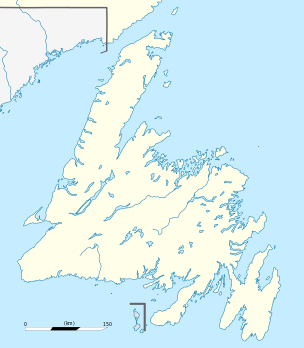Botwood
| Botwood | ||
|---|---|---|
| Town | ||
|
Overlooking Botwood facing east | ||
| ||
| Motto: En Avant (French for "Onward") | ||
 Botwood Location of Botwood in Newfoundland | ||
| Coordinates: 49°09′00″N 55°22′00″W / 49.15000°N 55.36667°WCoordinates: 49°09′00″N 55°22′00″W / 49.15000°N 55.36667°W | ||
| Country |
| |
| Province |
| |
| Census division | 6 | |
| Area | ||
| • Total | 15.05 km2 (5.81 sq mi) | |
| Elevation | 41 m (135 ft) | |
| Population (2006) | ||
| • Total | 3,052 | |
| • Density | 200/km2 (530/sq mi) | |
| Time zone | Newfoundland Time (UTC-3:30) | |
| • Summer (DST) | Newfoundland Daylight (UTC-2:30) | |
| Postal code span | A0H | |
| Area code(s) | 709 | |
| Website |
town | |
Botwood is a town in north-central Newfoundland, Newfoundland and Labrador, Canada. It is in Division No. 6, in the Bay of Exploits. The town is centred on its sheltered, deep water port used by cargo vessels.
History
In 1908 construction began on the Botwood Railway, running between Bishop's Falls and Botwood. It was a joint effort between the A.N.D. Company and the A. E. Reed Company of Bishop's Falls. It was to be the transportation link for the export of pulp and paper from the newly built mill at Grand Falls. The railway became operational by the fall of 1909, and the first shipment of paper from the new mill was sent in February 1910. The A.N.D. Company took control of the railway operation in 1910, just a year after the line was completed.
The first aircraft facilities to be established in Botwood was by Newfoundland born Captain Sydney Bennett (1897–1945) and Australian-born Major Sidney Cotton (1894–1969). It became host to many dignitaries and celebrities, some as part of official delegations and others who were stalled there waiting out inclement flying weather. Among those were Charles Lindbergh and his wife Anne Morrow Lindbergh in 1933. Both Franklin Delano Roosevelt and Winston Churchill overnighted at Botwood. Bob Hope and his troupe were stormbound there in 1943 and performed for the RCAF Coastal Command.
From 1937 to 1945, both Pan Am and the British Overseas Airways Corporation used Botwood as a terminal for their Atlantic Crossings. On June 27, 1939 the Yankee Clipper left Botwood for the first Trans-Atlantic Passenger flight to Foynes, Ireland.
From the outbreak of World War II, 1940–1945, the Royal Canadian Air Force changed Botwood into a patrolling and bombing seaplane base, home to two squadrons of PBY Canso flying boats equipped with torpedoes and depth charges. A large concrete slipway, two hangars, a tarmac and four bunkers were constructed. The Canadian Army was garrisoned in the town, the army built barracks, a water system, and a full-scale military hospital. The army was responsible for the manning of gun batteries at Philip's Head and Wiseman's Cove that protected the entrance to Botwood Harbor with 10" guns, as well as numerous anti-aircraft batteries throughout the community. At the war's end Botwood had been home to some 10,000 Canadian and British personnel and had become Canada's most important over-seas base.
In 1942, 11 United States military personnel died when their Sikorsky VS-44 flying boat, the Excalibur, crashed and sank in the Bay of Exploits shortly after takeoff from Botwood.
Population
| Population in 2006 | 3,052 |
| Population change from 2000 | -5.2 |
| Median age | 45.6 |
| Number of families | 985 |
| Number of married couples | 765 |
| Total number of dwellings | 1,305 |
| Land area (km².) | 15.05 |
Statistics Canada detail demographics
Climate
| Climate data for Botwood | |||||||||||||
|---|---|---|---|---|---|---|---|---|---|---|---|---|---|
| Month | Jan | Feb | Mar | Apr | May | Jun | Jul | Aug | Sep | Oct | Nov | Dec | Year |
| Record high °C (°F) | 13 (55) |
13 (55) |
15.5 (59.9) |
24 (75) |
28 (82) |
33 (91) |
35 (95) |
36.7 (98.1) |
29.4 (84.9) |
26.1 (79) |
20 (68) |
13.9 (57) |
36.7 (98.1) |
| Average high °C (°F) | −2.9 (26.8) |
−3.4 (25.9) |
0.9 (33.6) |
6.2 (43.2) |
12.4 (54.3) |
17.9 (64.2) |
22.5 (72.5) |
21.7 (71.1) |
16.7 (62.1) |
10.5 (50.9) |
4.9 (40.8) |
−0.4 (31.3) |
8.9 (48) |
| Average low °C (°F) | −12.4 (9.7) |
−12.9 (8.8) |
−8.1 (17.4) |
−2 (28) |
2.5 (36.5) |
6.9 (44.4) |
11.4 (52.5) |
11.2 (52.2) |
7.3 (45.1) |
2.6 (36.7) |
−1.9 (28.6) |
−8.2 (17.2) |
−0.3 (31.5) |
| Record low °C (°F) | −30 (−22) |
−36.7 (−34.1) |
−30 (−22) |
−19 (−2) |
−6.7 (19.9) |
−2.8 (27) |
0 (32) |
−1.1 (30) |
−4.4 (24.1) |
−8 (18) |
−16 (3) |
−28.9 (−20) |
−36.7 (−34.1) |
| Average precipitation mm (inches) | 83.8 (3.299) |
74.8 (2.945) |
74.1 (2.917) |
64 (2.52) |
73.2 (2.882) |
88 (3.46) |
76.8 (3.024) |
96.8 (3.811) |
91.9 (3.618) |
106.1 (4.177) |
78.6 (3.094) |
78.4 (3.087) |
986.4 (38.835) |
| Source: Environment Canada[1] | |||||||||||||
See also
References
- ↑ Environment Canada Canadian Climate Normals 1971–2000, accessed 15 July 2009

